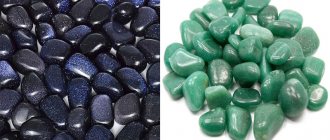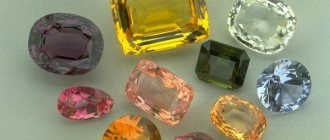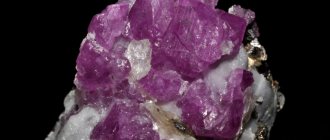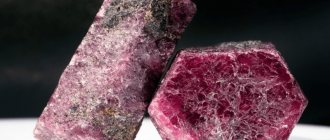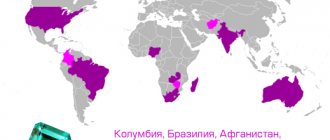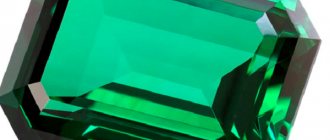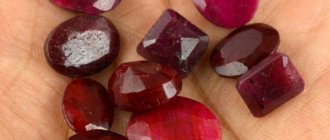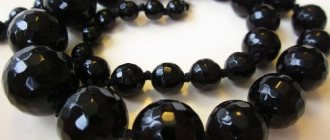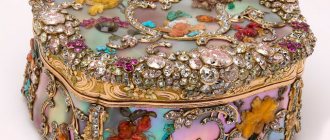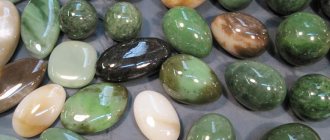| Stone type | Precious, semi-precious |
| Prevalence (Deposits) | India, Kazakhstan, Canada, Russia, USA, Thailand |
| Varieties | Leucosapphire, Padparadscha, Ruby, Sapphire, Chlorosapphire |
| Transparency | Transparent |
| Shine | Glass |
| Mohs hardness scale | 9 |
| Chemical composition | Al2O3 |
| Color | Colorless, yellow, green, red, orange, purple, pink, blue, lilac |
| Owner's color type | Not found |
| Owner's temperament | Melancholic, phlegmatic, choleric |
| Names | Not found |
| Zodiac sign | Aquarius, Cancer, Pisces |
| Date of Birth | from January 21 to February 18 from June 22 to July 22 from February 19 to March 20 |
| Chinese horoscope | Not found |
| Element | Water, Air |
| Planet | Not found |
| Day of the week | Not found |
| Month | Not found |
| Season | Not found |
| Numerology vibration | Not found |
| Chakra | Ajna, Anahata, Vishuddha, Manipura, Muladhara, Svadhisthana |
| What stones is it compatible with? | Alexandrite, Amethyst, Ruby, Sapphire |
| What stones is it not compatible with? | Not found |
| Therapeutic effect (problems) | Vision, nervous disorders, stress |
| Therapeutic effect (on organs) | Skin, gastrointestinal tract, cardiovascular system |
| Magic properties | Spiritual development, negative energy, self-confidence |
Precious stones have been used since ancient times. Rubies and sapphires could be found on the robes of the Egyptian pharaohs and on the ceremonial utensils of the Jewish high priests. These precious stones were incredibly expensive, so not everyone could afford them. At the end of the 19th century, their artificial analogues appeared. Ruby corundum, unlike ruby, was cheaper, but at the same time had the same quality characteristics.
What is ruby and sapphire corundum
Ruby and sapphire are nothing more than varieties of corundum, a hypogene group mineral. Therefore, both of these species have similar physical properties and chemical composition. The main difference is the impurities that are responsible for the color of the gemstones. For ruby it is chromium, and for sapphire it is titanium. Both minerals belong to category I precious stones, which guarantees their high price.
Sapphire and ruby corundum are synthetic stones obtained in a laboratory. This is a kind of budget alternative, with a wide range of applications: from jewelry to rocket science.
No. 4 With what and who to wear a precious ruby
Just because you know the answer to the question whether a ruby is a precious stone or a semi-precious stone, does not mean that you know what to wear it with. The fashion for combining rubies with other stones changes every season, but fortunately the classical rules apply everywhere. For example, it is better not to wear rubies accompanied by sapphires, but a ruby and a diamond are old comrades who peacefully coexist in the same frame and emphasize each other’s features.
Rubies are not worn with semi-precious stones, unless they include cubic zirconia, an inexpensive artificial diamond. The textbook setting for a ruby is called red and yellow gold (the shade is chosen based on the shade of the stone: yellow gold for an orange ruby, red for violet and scarlet). Red gold with a ruby is acceptable only in the evening, but white gold contrasting with the stone can even be worn to work. The main thing is that the weight of the stone does not exceed 1 carat (0.3 grams).
A ruby in silver is an accessory for a business image; schoolgirls and students can also wear it. Light jewelry made of silver - a ring with a thin rim or a delicate oblong pendant - is given as a gift for coming of age and family holidays. Ruby jewelry should be stored in separate boxes and worn with clothes in warm colors.
Still have questions? Leave a request and we will contact you!
Order a consultation
We recommend that you familiarize yourself with the catalogs:
- Ruby rings
- Earrings with ruby
- Stud earrings with ruby
- Pendants with ruby
How to distinguish from ruby
Natural stone corundum is a gem of natural origin. It is formed at great depths from igneous rocks. It is a mineral obtained by metamorphosing bauxite, an ore based on aluminum oxide.
The same type of ore is used in the synthesis of ruby corundum in the laboratory. The resulting product has the same crystal lattice and basic characteristics as its natural counterpart. It conveys well the shades of red and its neat shine.
The main advantage of synthetic stone is cost. It is much cheaper than natural ruby. Fraudsters often take advantage of the similarity, trying to pass off an artificial gem as a natural one. However, if you wish, you can easily distinguish a fake from the original.
- Synthetic stones change color when exposed to ultraviolet irradiation (ruby corundum begins to glow orange).
- The surface of an artificial crystal is usually covered with straight horizontal shading. In natural stone it is most often zigzag and curvilinear.
- An original can leave a scratch on the glass, a synthetic ruby cannot.
- Price is an important marker that allows you to identify the original. Artificially grown rubies are many times cheaper than natural ones.
What are the differences from sapphire
Sapphire corundum and sapphire are even more difficult to distinguish from each other than ruby and its artificial counterpart. There are several characteristics that will help identify a laboratory product.
- Hardness. Natural mineral is much harder than artificial one. You can easily verify this by simply running a stone across the glass.
- Structure. Synthetic gems are characterized by purity. But inside a natural formation you can often find minor defects: air bubbles, chips, scratches.
- Light refraction. This indicator is measured by a special device called a refractometer. A real sapphire has a value of 1.762-1.778. Any deviation indicates a fake.
- Irradiation. When exposed to UV rays, sapphire corundum turns a dirty green color, indicating the presence of a large percentage of titanium oxide.
- Asterism. “Stellarity” is found only in natural minerals.
Be sure to see: How to distinguish natural alexandrite stone from artificial
Today, scammers often sell duplex stones - a combined synthetic and natural gem. You can detect them with a magnifying glass. A thin groove will be visible in the structure of the mineral.
How to check the authenticity of a breed at home
If you want to know more about a stone that has already been purchased and is at your disposal, you can try to check its authenticity yourself, at home. There are several ways to do this.
- Option one. Prepare any glass container. It doesn’t matter what volume and shape it will have, the main thing is the transparent walls. Place the pebble in the bowl. If it is a real ruby, regardless of the carat, it will glow with beautiful red rays. A fake does not have this effect.
- Method two. Examine the pebble in the light (natural lighting is a must). If this is a real ruby, then in the sun it will sparkle with different shades depending on the degree of lighting. Opposite the sun, the mineral will glow burgundy, and on the other side it will glow with a pale and matte light.
- The third method is using milk. A ruby is placed in a glass of milk. If it changes color to pink, then the gem is real. And the point here is not in chemistry, but in the optical effect - the stone glows so brightly that the illusion of coloring the milk is created.
- The fourth method is exposure to ultraviolet light. The synthetic analogue will remain red under UV rays, while the genuine samples will take on a warm orange tint.
- The fifth method is to study the internal component. In fake and real stones you can see bubbles inside, but in the former they are filled with air, and in the latter they are filled with gases.
- Method six - strength test. If you try to scratch the surface of a ruby with glass, the scratches will come out uneven. In imitations, damage of this kind is usually straight and glossy.
- Method seven - heating. Natural rubies heat up very slowly. It is easy to feel if you hold the stone in your palm. Imitations quickly absorb the heat of the human body. By this feature they can be easily distinguished from the original.
The weight of the mineral is another important property to pay attention to. Original breeds are always noticeably heavier than fakes, harder and more solid.
History of the stone
Corundum has been known since ancient times. In Ancient Egypt, nobles and priests decorated their clothes with sapphires and rubies. Gemstones were used during religious and occult ceremonies in Ancient Persia, Mesopotamia, India and China.
In Rus', yakhont, as corundums were called, appeared much later. Rubies were called scarlet yachts, and sapphires were called azure. Green chlorosapphires were called “oriental emeralds”, and purple ones were called “amethysts of the East”.
Classification of corundum…CORUND Characteristics of the mineral.
After diamond, corundums are the hardest... Published by Sapphire.Sapphire Thursday, November 8, 2012
Corundum came to European countries from the mines of India. Sapphires and rubies quickly gained popularity and recognition, even among royalty. Many regalia, including the crown of the British Empire, are decorated with these precious minerals.
Pure rubies “the color of pigeon blood” were valued higher than diamonds and were often presented by diplomats of countries as a sign of peaceful and noble intentions.
Interesting! Most of the most famous cut rubies do not boast much weight, as jewelers specially cut them to relatively small sizes. The fact is that the smaller the red stone, the brighter and more saturated it shows its shade.
Features of artificially grown samples
Jewelry is rare in nature, which is why its value is constantly growing. The price of substitutes produced in laboratories is significantly lower. At the same time, only a professional can distinguish a fake from a natural gem. That is why synthetic analogues are in particular demand and popularity.
Externally, the synthetic mineral is also not very different from the natural one. And thanks to modern manufacturing technologies, the product can be given virtually any shade and saturation. Hydrothermal or nanosapphires are grown from scratch or made from corundum. You can give them the desired tone using coloring. The chemical component of natural and artificially grown pebbles is aluminum oxide. They also do not differ in Mohs hardness (9 out of 10 points).
Physical properties and chemical composition
The basis of both natural and synthetic corundum is aluminum oxide. Foreign impurities are responsible for the color of the stone and its variety. Pure natural corundums are usually colorless. Although they are called white, they are particularly transparent with a glassy sheen.
Titanium oxide gives the mineral a blue tint, classifying it as a type of sapphire. Chrome “gives” the stone its red color and all its variations, thus creating rubies and carbuncles. Iron oxide gives the mineral a golden hue, manganese gives it a pink or purple hue, and the combination of iron, manganese and chromium gives the green chlorosapphires, which are so often confused with emeralds. Vanadium in combination with iron in the gem gives it a brown or amber hue, somewhat reminiscent of rauchtopaz.
The hardness of natural stone is 9 points on the Moss scale. It does not dissolve in acids and melts at temperatures above 2050°C.
Artificial corundums are often subjected to ultraviolet irradiation or heating. This has almost no effect on their chemical composition, but affects the appearance, namely the shade of the stone.
Basic modern methods of growing rubies
Today, only modern methods of growing crystals are used, where attention is mainly paid to the speed of obtaining finished specimens. Methods are distinguished:
- Vernel method - the manufacturing principle is to mix chromium and aluminum oxide. As a result, after melting, a cylindrical crystal is formed.
- Czochralski method - mined by pulling a seed crystal upward from the surface of a large volume of starting material. This method of preparation produces very large crystals.
- Zone melting method - the method is similar to the previous method, but pulling occurs along the heating element. The result is a plate-shaped crystal.
- Garnissage melting - the substance melts and crystallizes, while its own cold zones are located around it. Heating occurs by radiation, which results in columnar specimens.
- Hydrothermal synthesis is used exclusively for the manufacture of jewelry crystals. To obtain it, a solution of a more fusible substance is used. The result is large specimens.
The method of obtaining crystals pleases with its advantages and disappoints with its disadvantages, so the most convenient and suitable for the targeted formation of specimens is chosen.
Synthetic corundum has a right to its existence, and should not be abandoned. If you want to purchase voluminous jewelry, but at an attractive and affordable price, it is better to choose an artificially produced ruby rather than buy a fake in the form of painted glass.
How to distinguish natural from fake
Stones of artificial origin cannot always be distinguished from natural ones. If possible, you should use special equipment: a microscope or a magnifying glass. You can even ask a specialist for help - a professional jeweler.
Using a magnifying glass, the structure of the stone is studied. The presence of bubbles and minor defects indicates its natural nature. If the seller allows, you can heat the stone and evaluate the range of changes in its color. Genuine rubies and sapphires do not change shade. In addition, they are harder than synthetic analogues or artificially created duplexes. This can be checked by simply running the gem across the glass.
The presence of certificates confirming the natural origin of the stone is also of great importance. In addition to the basic physical characteristics, the documents must indicate the mineral deposit.
Are you fascinated by ruby corundum jewelry?
VeryNo
Appearance of the gem
Sapphire is a subtype of corundum. Initially, this stone has different shades of blue, from bright blue to purple. There are also yellow, powdery, green and amber-colored gems. In terms of chemical components, it is aluminum oxide, the structure of which contains impurities of iron and titanium. It is due to these components that the stone has a rich blue tint. The mineral is distinguished by its rigidity and refractive power, which gives it a pronounced shine.
The unprocessed mineral is distinguished by its uneven outline and color intensity. It is processed using a variety of methods. The most common are the facet cut and the cabochon technique, which makes the surface of the mineral smooth and smoothes out the edges. The facet cut is different in that it can be used to give the stone a variety of shapes, for example, a heart, a triangle or an octahedron. It is this type that is most often used for processing star sapphires, the structure of which contains rutile. The most valuable gemstones are deep blue, the shade of which is close to cornflower blue. Pale blue and dark blue minerals are not valued as highly.
Attention! Red sapphires do not occur in nature. Corundum, which has a rich red and garnet hue, is called ruby.
Healing properties
Natural stones have long been credited with healing properties. It is believed that corundums can have a beneficial effect on the following systems of the human body:
- cardiovascular;
- digestive;
- urinary;
- circulatory;
- endocrine.
Blue sapphire is good for the eyes, according to traditional healers, as it normalizes intraocular pressure. Yellow varieties improve metabolism and have a rejuvenating effect. Therefore, stones of a golden-sunny hue are often presented as gifts to women.
Be sure to watch: All about freshwater pearls
Description
Corundum is a crystalline aluminum oxide with an uneven surface. The mineral is dichroic, dense and so hard that only diamond is harder than it. In nature, there are both individual minerals in the form of crystals and fused into “barrels” or columns. The natural colors of corundum are red, black, yellow, pink, white and green. And this is the first difference between corundum and ruby, which comes only in red or red shades.
Varieties of corundum include sapphire (blue, green, violet), leucosapphire, ruby, padparadscha, and amethyst.
As for ruby, the more chromium it contains, the deeper its red color. If you shine ultraviolet light on the stone, it will turn orange. Rubies can be obtained artificially (the Frenchman Auguste Verneuil succeeded for the first time in 1904); such samples are sometimes called spinel.
There is a theory that rubies are unripe sapphires. After the collapse of Pangea (an ancient single continent), one large deposit was destroyed. Some of the rubies remained in the rocks of the earth, where the stones under pressure continued to become saturated with metal oxides and “turned red.” The other part set off on a journey through oceans and rivers, turning blue and yellow along the way.
Magical meaning
Sapphires and rubies have been used in occult rituals since ancient times, so it has always been endowed with magical properties. According to esotericists, corundum is capable of exerting a powerful influence on the course of thoughts and actions of its owner. This is a stone of active and purposeful individuals, people with ambitions and high expectations.
Corundum will help you concentrate on the path to your goal. The stone actively supports the owner, driving away fears and increasing self-confidence. However, at the same time, it requires energy and active action from the owner. The gem is not suitable for lazy and mediocre people.
Blue sapphire is often given to people whose work involves mental activity. It is a stone of scientists and researchers. A real natural ruby can protect against negative energy and support in times of crisis. Earrings with this stone will help you find harmony, both with yourself and with the world around you, and a ring will allow you to reveal your hidden potential.
No. 3 The healing potential of ruby
A ruby in silver, whose magical properties are to gently heal the owner from insomnia, help in communicating with people and maintain a fighting mood, is sometimes used as a medicine. Is treatment with stones effective? It’s better to ask magicians. But ruby managed to become famous for some properties. For example, in India it was considered a divine stone that helps women produce healthy offspring and facilitates childbirth. In Ancient Greece, diseases of the spine and joints were treated with ruby - the stone was applied to painful points on the body and heated.
In the Middle Ages, it was believed that constantly wearing a ruby - especially if this amulet was given as a gift in childhood - increases immunity and protects against diseases of the gastrointestinal tract. For people over 50 years old, ruby is valuable for its effect on the nervous system. The stone trains the nervous system and strengthens the heart. Rubies are given to children as pendants; it is better to wear them under clothes, closer to the heart. For older ladies, a ring with a ruby in gold is suitable. By the way, this accessory is the best family heirloom! Ruby does not age over time and does not lose strength.
Who is it suitable for?
Corundum is not suitable for everyone. When choosing jewelry with any type of this mineral, you need to take into account both external data and zodiac affiliation.
By zodiac sign and date of birth
The influence of corundum on its owner is closely related to his zodiac sign.
| Zodiac sign | Type of corundum (color) | Influence |
| Aries | Sapphire blue and yellow | Aries should wear corundum only after 40 years. In this case, they will work as amulets, providing, among other things, a rejuvenating effect |
| Taurus | Blue and cyan sapphire | A Taurus talisman with a stone will protect you from illness, allow you to develop intuition and realize hidden talents. The mineral has a good effect on memory |
| Twins | Dark blue, purple sapphire | Geminis wearing the stone will have improved leadership qualities. Sapphire will not allow the owner to quit halfway |
| Cancer | Any shade of sapphire and ruby | The stone as a talisman will reveal your potential and bestow extraordinary luck. Corundums make Cancers more positive and open |
| a lion | Contraindicated | Wearing a stone can lead to aggravation of relationships with loved ones, conflicts with loved ones |
| Virgo | Green and blue sapphire | Corundum will give a skeptical Virgo positivity and encourage dramatic changes in life. |
| Scales | Purple sapphire, red ruby | The combination of Libra and corundum is the key to success. Representatives of this sign, equipped with a talisman, will experience success in any endeavor |
| Scorpion | Red and pink ruby | For closed Scorpios, the gem will help them make friends and improve relationships. Red ruby ignites passion |
| Sagittarius | Black blue sapphire | The stone teaches sharp Sagittarius delicacy and diplomacy, brings idyll and peace to the house |
| Capricorn | Contraindicated | The gem enhances phobias and negative character traits |
| Aquarius | Transparent corundums | The stone will help this sign find its life path and attract good luck. |
| Fish | White corundums | For altruistic Pisces, the mineral will help replenish energy reserves and ward off melancholy |
If we talk about dates of birth and their connection with the zodiac, then corundum is a talisman for those born on the following days:
- Aries – March 22, 28;
- Taurus – April 26;
- Gemini – May 21, 27;
- Cancer – June 21;
- Leo – July 25, 25;
- Virgo – September 6, 17;
- Libra – October 19;
- Scorpio – October 25, November 8;
- Sagittarius – December 14, November 29;
- Capricorn – January 2, 8;
- Aquarius – January 29, February 6, 17;
- Pisces – February 21, March 7.
Knowing the talisman stones by date of birth, you can choose a successful and useful gift.
By color type
Color type is a person’s natural palette, characterized by the color of hair, skin and eyes. There are 4 main types of appearance in nature, which are correlated with the seasons.
| Color type | Characteristic | Stone |
| Summer | Blonde hair, translucent pink skin, gray, green and blue eyes | Blue sapphire |
| Autumn | Dark brown, brown and red hair, slightly dark skin, brown and green eyes | Chlorosapphires, red rubies |
| Winter | Dark hair, white “porcelain” skin, blue, green and gray eyes | Ceylon dark red rubies, black and blue sapphires |
| Spring | Light blond, wheat-colored hair, brown and green eyes. Peach skin tone | Yellow, pink sapphires, padparadscha rubies |
The table presented will help you choose the most successful option for decorating with a stone.
Photos of minerals and products made from them
Frames for rings, pendants, and bracelets made from elite varieties of corundum are made from platinum, gold, and silver. The precious mineral is processed using the cabachon method.
Jewelry with inserts of blue and green sapphire and red ruby look exquisite and emphasize the status of the owner.
By the way! Jewelry made from transparent crystals in rich colors looks no less impressive than diamonds.
Deposits: where there are formations of natural mineral
The most famous deposits are located in a place called the “Asian quadrangle”. It includes Myanmar, Thailand, Sri Lanka and India.
The purest rubies are mined in Burma. Rare chlorospaphyres and black-blue stones are found in deposits in Australia and Tanzania.
In Russia, mining is carried out in the Urals, Primorye and Krasnoyarsk Territory, and one of the most recently discovered deposits is mines in Kazakhstan. Precious corundum is also mined in the USA, Canada, Norway and Greece.
Interesting! According to geological data, the world's sapphire reserves are 20 times higher than ruby reserves.
What is the difference between them
Although corundum and ruby are identical in origin, there are differences between them. Ruby is a more refined version of corundum and has greater value in the jewelry market. Here are the markers by which you can find out how they differ.
Corundums have an imperfect structure, where microcracks are pronounced, inadequate transparency is observed, and foreign inclusions are possible. The color is often muted, not intense. Under sunny colors, individual fragments of a pebble play differently under the light (this phenomenon is called dichroism). Corundums are not subjected to full jewelry processing - the edges are cut with special equipment according to a certain technique.
Rubies are a luxury version of corundum. Its structure is closer to flawless, it is completely transparent, without foreign inclusions. It has bright, rich shades and, under lighting, plays harmoniously with all its facets (uniform light refraction). Subjected to detailed jewelry processing.
Application
In addition to the jewelry industry, corundum derivatives are actively used in a variety of industries. In optics and instrumentation, sapphire glass is used to increase the strength of lenses. In the aircraft industry, windows are equipped with this part.
In mechanical engineering and machine tools, corundum with a high iron content is used as an abrasive material. Artificial sapphires are needed for the production of medical instruments, luxury watches, mobile gadgets and digital equipment.
In construction, corundum is used as a component of the thermal insulation layer.
About the features of natural ruby
Natural ruby is a type of corundum, which also includes sapphire and other gems. Rubies mean corundums, which have all shades of red, rich lilac and red-brown. Sapphires include pink and almost transparent specimens, but the composition of the varieties is similar. The exception is chromium, which is what gives the gem its red tint. The more of this substance, the more red the color in the gem.
Natural corundum is dense and is second only to diamond in terms of performance. Rubies have a characteristic iridescence in the light, they have shine and are very bright. Surprisingly, transparent pink corundums are predominantly found in jewelry. This is explained by the cost of the gem - a real ruby is very expensive, so jewelers prefer to use specially grown specimens that can look similar to a natural stone. The cost of a ruby per carat is about $600, and artificially grown specimens are 2-3 times cheaper.
Price
The price of a stone depends on a number of its parameters, such as:
- purity;
- weight;
- shade;
- cut.
Category I rubies can cost up to $1,500 per carat. But the cost of the same stones, but category III, will be significantly different and will not exceed $400-500 per unit of weight.
The most expensive rubies are those from Burma. They are sold exclusively at auctions, where the price per carat starts at $3,000.
Sapphires are cheaper, somewhere around $150 per carat. However, the larger the stone, the higher the price per unit weight. Minerals larger than 8-9 carats cost at least 10 thousand dollars on the market.
Storage and care of the gem
Despite the durability of the stone, there are a number of recommendations for caring for it so that it pleases its owners longer:
- It is not recommended to wear the mineral in sunlight for more than 3 hours a day. Ultraviolet radiation dulls the color of the stone. The more often you expose it to sunbathing, the faster it will become unattractive.
- It is recommended not to use aggressive detergents when treating stone. It is wiped with a soft cloth (velor, microfiber) or wiped with a soft bristle brush.
- Store the mineral in a box, upholstered with soft fabric and reliably hiding the jewelry from sunlight.
Main conclusions
Ruby corundum is an artificial analogue of natural stone with an identical crystal lattice structure and a similar chemical composition.
- Like ruby, sapphire corundum is a laboratory-grown mineral.
- You can distinguish artificial analogues from the original by visually examining the structure, heating or irradiating the stone.
- The color of corundum is closely related to its composition, namely to the impurities that are contained in small quantities in the ore.
- The areas of application of the stone include both jewelry and industrial sectors.
- If you wish, you can choose a stone based on your zodiac sign and birth period.
Corundum can be an excellent talisman if you choose the right variety and don’t forget to care for it regularly.
Share your opinion about this amazing mineral and stories about your talismans and amulets with precious and semi-precious stones.
Horoscope and magic
The mineral has a fiery nature, so it is perfect for Fire signs (Aries, Sagittarius, Leo). With its help, signs rationally use the qualities given to them at birth: perseverance, determination, firmness, decisiveness, confidence, leadership inclinations. But there are no people consisting of only positive qualities. Fire signs are impulsive, self-centered and have difficulty reading the emotions of people around them. Ruby helps smooth out sharp conflict angles and also improves interpersonal understanding.
Magicians and esotericists believe in the great power of the fire stone. They believe that it is able to kindle feelings between people and increase attractiveness in the eyes of the opposite sex. Besides this he:
- Strengthens the willpower of a person, makes him stronger and more resistant to difficulties.
- Stimulates physical and mental activity.
- Protects the owner from external negativity (anger, envy, aggression, slander).
What stones are confused with ruby?
How to distinguish a natural and artificial ruby? Here you need to understand that jewelry may contain not only natural and synthetic red corundum, but also other stones that may try to pass off as rubies. For example it could be:
- Almandine is a hard garnet. But it is inferior in strength to corundum.
- Pink and red spinel.
- Pink topaz. Jewelers call it “Brazilian ruby”.
- Cuprite. Stone made of copper compounds.
- Red tourmaline. You can also hear the name “Siberian ruby”.
- Red sphalerite. Rock stones found in Spain.
- Rose quartz.
- Composite red corundum. Natural stone is fused with glass to increase size and weight, and therefore cost.
- Red glass. The cheapest imitation corundum.
All of these stones and materials have a hardness lower than that of ruby.
Synthetic ruby - fake or precious stone
Artificial rubies are often found in jewelry. At the same time, sellers do not mention that the corundum in the product was synthesized and call it natural. Are they deceiving the buyer or not?
Technically, still no. Natural and artificial rubies have the same chemical composition and absolutely identical properties. They have the same hardness. At the same time, synthetic stone is cleaner and has higher transparency, since there are no various inclusions. But natural stones are more expensive.
Corundums: rubies and sapphires. Learn more about sapphires. Part 4.
MORE DETAILS ABOUT SAPPHIRES.
As you know, the main difference between sapphire and ruby is not the color, but the chromophore, to which corundum owes its color. The main chromophores of corundum are titanium, iron and chromium. Only when the influence of chromium prevails over the influence of titanium and iron is corundum considered ruby. In all other cases, even when the color is controversial, that is, completely “ruby,” the stone will be recognized as sapphire if the above condition is met. The test for “sapphire” or “ruby” of corundum is very complex and can only be carried out in a well-equipped gemological laboratory. Sapphires from Sri Lanka
Ceylon sapphires have been known since ancient times for their excellent quality and wide range of colors. Sapphires of all known colors are found in Sri Lanka, with purple and red being the rarest. Ratnaputra is an important and highly productive mining center and newly mined stones are offered in the local market daily. Sri Lanka is famous for producing the largest sapphires in the world.
Sapphires from the Ratnaputra region are distinguished, on the one hand, by a fairly significant content of rutile “silk”, but on the other hand, by weak fractures, the most complete crystallization among all sapphires from currently known deposits, and often by the almost complete absence of significant gas and gas-liquid deposits. inclusions. Another important feature of Ceylon sapphires is that they do not have very dark tones, which is of great importance for the sapphire market as a whole. Unlike Russia, where dark-colored blue stones are most popular and valued, throughout the world these are more likely to fall into the average quality category in terms of color. Medium dark, medium and even medium light tones are much more popular and highly valued.
Ceylon sapphires with a color changing effect and sapphires with an asterism effect are also highly valued.
Both of them are extremely rare, and are often used not as precious stones for the needs of the jewelry industry, but as collectible exhibits. Madagascar sapphires
Sapphires are found in Madagascar in numerous deposits throughout the country. The southern deposits at Ilalaka are geologically linked to sapphire deposits in Sri Lanka, East Africa and Tanzania. The northern deposits of star sapphires and the northern and central ruby deposits are not geologically connected to the southern ones, and the origin of these deposits still remains a mystery. Many of the Madagascar sapphires have amazing, if not outstanding, colors! Unfortunately, Madagascar is politically very unstable. The country is very underdeveloped economically, there are practically no roads. Even on the geographical maps of Madagascar there are still a lot of dotted lines and even blank spots. About 10% of the country's territory is so inaccessible that it has not even been explored or mapped yet. In Madagascar there are practically no competent specialists capable of searching for and finding new deposits. And yet, Madagascar can certainly be called a storehouse of precious stones and minerals. And in the near future, Madagascar will, of course, become the main source of sapphires, rubies and many other varieties of precious stones on the world market.
Madagascar sapphires from southern deposits are most similar to Ceylon sapphires, although blue Madagascar sapphires have darker tones. Madagascar stones lag significantly behind their Ceylon counterparts in terms of completeness of crystallization, and because of this they significantly lose in “weight characteristics”. Due to the disproportionality of the shapes and sizes of Madagascar raw materials, large crystals weighing 10-20 grams very often have to be cut into several pieces before cutting.
The Madagascar material is generally much more included, fissured, and may have very large “windows” of gas inclusions. It was for Madagascar sapphires that methods for artificially treating cracks and cavities with lead glass were first developed. The purity requirements for Madagascar sapphires are somewhat more lenient than for Ceylon sapphires, but the monetary expression of their value is also inferior to Ceylon stones.
In terms of color, Madagascar sapphires are not inferior to Ceylon sapphires, if not superior! Madagascar is the absolute world leader in the production of colorless and pink (natural color) sapphires.
Sapphires from Kenya and Tanzania The most significant deposits in this region are the Umba Valley region in Kenya, and the Tunduru and Songea deposits in Tanzania. The deposits at Thunduru are geologically directly related to the original source rock of the supercontinent Pangea. Probably because the Tunduru region, like Ceylon, was closest to the “corundum” source. As in Ceylon, there are practically no red stones in Tunduru, although purple ones have already appeared. The Umba deposit is geologically connected with those of Madagascar. But the deposit in Songea is directly related to the deposits of the north of Madagascar. Of all the colors typical of corundums, green and red predominate in Songea. More often than in any other regions, star sapphires (Songea) and sapphires with the effect of changing light (Umbra Valley) are found in deposits in Kenya and Tanzania.
In deposits in Kenya and Tanzania (with the exception of Tunduru), classic blue sapphires are rare finds. The color palette, especially of Songea sapphires, is the richest in the world among all colored gemstones. Songhei sapphires, like rubies from this area, are distinguished by their exceptional purity of material, but at the same time by their very small size. A sapphire of 1 carat from Songea is already a rarity; one of more than 2 carats is almost a unique rarity! Sapphires from Australia Australia has quite a few small deposits of corundum that are rich enough for commercial exploitation. Probably, they also have a family connection with the supposed “single world center of corundums,” but this connection is the most distant. The vast majority of Australian corundums are very dark blue sapphires. Pure stones are much less common than in other sapphire mining areas, although in terms of size and weight, Australian sapphires can give a big head start to the rest of the world!.
Sapphires from Thailand and Cambodia.
In Thailand, commercial sapphire mining is also carried out in the Kanchaburi and Siam regions. The amount of material mined, especially in Kanchaburi, is growing from year to year, and on the world market these stones are beginning to seriously compete with those from Ceylon and Madagascar, but mainly due to price rather than quality. Thai sapphires are distinguished by good clarity, but most stones have very weakly saturated colors. Large stones, more than 1.5-2 carats, are rare. Quite a lot of very high-quality cabochon raw materials are mined in Kanchaburi.
Cambodia, gradually reviving after the horrors of the Khmer Rouge regime, is once again knocking on the world market with its sapphires. Production, which was completely stopped during the genocide, has increased significantly in recent years. Cambodian sapphires are distinguished by their purity, which is exceptional for Asian corundums, and the richness of their shades, which is rare in strength. Often both lucky factors in the value of a precious sapphire coincide in Cambodian stones!
Sapphires from other regions of the world.
First-class blue sapphires, although not in large quantities, have been found in Burma for centuries. Unfortunately, at present, due to the economic embargo, the supply of Burmese sapphires to the world market is completely absent.
Considered to be a large sapphire deposit in Montana, USA, it is currently mothballed due to commercial unprofitability. Low purity by international standards and weak color saturation do not allow sapphires from Montana to withstand competition on the world market.
Sapphires from South America come to the market sporadically, sometimes even of very high quality, but no significant deposits have yet been discovered there.
Since 2001, sapphires from Mozabique and Nigeria began to enter the world market. Mozambique sapphires are related to Tanzanian and Kenyan sapphires, and their deposit is the southern part of a large corundum-bearing zone. No large deposits have yet been discovered in Nigeria, but several significant alluvial placers have been found. The quality of Nigerian material is not the highest, but not the worst, so we can expect that Nigeria will still take its place in the corundum market.
So, as we see, nature has endowed corundums with a unique, rich color palette... But do not forget that man, thanks to his technical genius, has learned to enrich this palette very well!
The features of sapphires of various fancy colors, the difference between natural and introduced colors, and how to distinguish them will be discussed in a separate article.
The history of obtaining synthetic ruby
Synthetic corundum is also called hydrothermal. The first artificial corundum was born thanks to the work of Mark Gooden in 1837. However, there was no rush to adopt his successful experience. At that time, the very idea that people of modest means could wear jewelry was a crime in the eyes of the aristocracy.
Then, 50 years later, reconstructed rubies were obtained. They were melted from crumbs and fragments of natural corundum, so they cannot be called synthetic.
And finally, in 1892, a real breakthrough occurred. The Frenchman Auguste Verneuil completely abandoned the use of natural corundum and produced a synthetic stone made from aluminum oxide.

